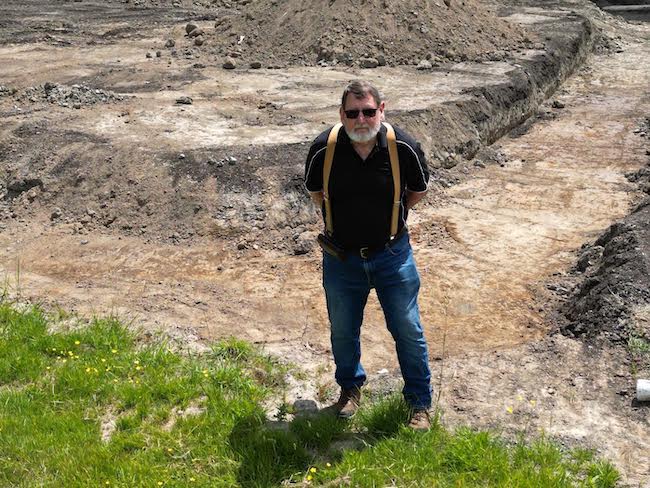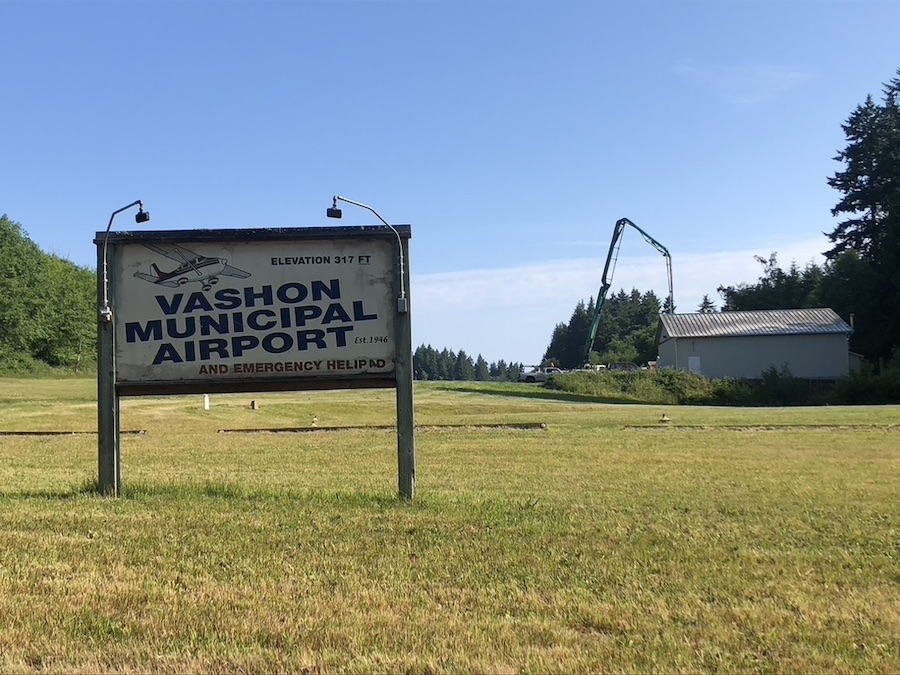This guest blog article is part of a series that addresses local water quality topics written by Mary Bruno, Vashon Groundwater Protection Committee member.
Did you know that the Vashon Municipal Airport is its own “Municipality”? Yeah, neither did I.
This official designation is enjoyed by any county, city, town, airport district or port district in Washington State. It makes our airport an independent, self-governing fiefdom in the heart of unincorporated King County. Vashon’s very own Vatican City. But these last six months, being a Municipality has caused the airport nothing but grief.
Vashon’s airport has been around since 1946. You’ve probably driven past its 20-acre site on the North side of Cove Road. It has a 2,000-foot-long turf runway and a helipad for emergencies. If disaster strikes, the airport will provide a vital link to the mainland, allowing pilots to shuttle supplies and people on and off the Island. “It is a huge asset for the community,” says Truman O’Brien, one of the airport’s three, elected commissioners.
The airport is owned by King County Airport District #1 (KCAD#1), which ensures its compliance with FAA requirements and safety regulations. Airport maintenance is handled by Vashon Air Service (VAS), the association of 43 pilots who currently lease the lots and hangars that line both sides of the airport’s runway. The troubles began in November 2020 when KCAD#1 approved a VAS member’s request to build a hangar on his lot.
As a Municipality, KCAD#1—not King County—has the power to issue building permits on airport property. Construction of the hangar in question began in November 2022. That’s when Truman and his fellow commissioners discovered that the hangar’s lot had been topped with a layer of Recycled Asphalt Pavement. RAP, as it’s known, is ground up asphalt from old roadways that are being replaced or resurfaced. The airport RAP probably came from a 12-mile stretch of Vashon Highway that was replaced a few years back.
Because RAP contains toxins such as lead, arsenic and carcinogenic organic compounds, King County expressly prohibits its use on Vashon: “Recycled asphalt shall not be used in areas subject to exposure to seasonal or continual perched ground water, in a critical aquifer recharge area or over a sole-source aquifer.” (Title 16, Section 16.82 16.82.100 Grading standards. 4d )
KCAD#1 never approved any plan to use RAP, or to install a 1,500-gallon sewage holding tank, which the VAS member also did. The hangar site sits on the East side of the airport runway, just above Shinglemill Creek. Airport commissioners were alarmed. “Not only does the airport need to be a good neighbor,” says Truman O’Brien. “We need to be good stewards of the land. That’s very important to us.” KCAD#1 issued a stop-work order on December 15, 2022.
Truman responds with a sarcastic chuckle when I ask about what happened next. For help with the RAP problem, he started at King County’s Department of Local Services and Permitting. Two weeks later, the County prosecuting attorney’s office informed him that since the airport is a Municipality the County had no jurisdiction in the matter. Translation, says Truman: “‘You’re on your own.’”
Next stop: The State Department of Ecology. Truman contacted Dawn Marie Maurer, a Facilities Specialist for the State Department of Ecology’s Northwest Region. He was referred to Maurer by the Island contractor who had applied the airport RAP. Maurer replied via email: “Commissioner, . . . there are no state restrictions on the use of recycled asphalt. In fact, it is a very commonly used material in construction as a base layer. I’m afraid that in this case, you have a county code that prohibits a recycled material from being used in a certain way, but without basis in state regulations.” To be safe, Truman checked with Maurer’s boss, the Director of DOE’s Northwest Region Office. He confirmed that the agency, “Has no problem using [RAP],” adding “If you really want the definitive answer you should contact Dawn Marie Maurer.”
The airport considered removing the RAP itself—until it got a $130,000 estimate for the job. At that point, says Truman, “We had two options. We could [sue the hangar owner], go into litigation and leave this stuff exposed to the elements for God knows how long. Or we could come up with a plan to encapsulate it. We took the lesser of the two evils.” Encapsulation.

Airport Commisioner Truman O’Brien hopes that encapsulating the exposed RAP will solve the problem. Credit: Truman O’Brien
After lengthy discussions, the hangar owner agreed to contain the threat by pouring a deep concrete footing around the perimeter of the hangar site and covering its RAP-topped surface with a concrete floor. “Any RAP left outside this encapsulation will be removed from the site,” says Truman. The owner also got rid of the sewage holding tank. KCAD#1 lifted its stop-work-order on May 31. Construction resumed on June 1. Truman is using his drone to track the work. So far, so good, he reports. “They’re following our direction perfectly.”
The solution isn’t risk free. The underside of the concrete capsule will remain unsealed, allowing for the possibility that during an especially rainy spell a rising water table could saturate the RAP from below and send any leached toxins down the hillside. Monitoring drainage from the hangar lot seems wise, and “is certainly something that we’d want to do,” says Truman. The Vashon Nature Center already conducts annual surveys of Shinglemill Creek invertebrates. “We have some baseline water quality data as well as stream bug data that could be helpful in picking up any impacts,” says VNC’s executive director Bianca Perla. “For example, I would expect to see a drop in the pollution sensitive species if the RAP starts to impact the stream.” Airport commissioners have also revised KCAD#1’s Rules and Regulations to help prevent a repeat of the incident.
Mitigation aside, the airport RAP case raises two vexing issues. The first involves King County’s decision to opt out. It is certainly true that the County has no legal jurisdiction over airport land use. But what about the potential threat of toxic effluent flowing onto the adjacent property that is governed by the County? That land includes the Shinglemill Creek watershed and the Westside Water Association, which supplies drinking water to more than 200 households. Is the County not bound by its own ban on RAP to do something? “Our service is limited to preventing the placement of potential contaminants, like RAP, to limit environmental impacts,” writes Jim Chan, Director of the County’s Permitting Division, in an email response.
Asked about monitoring drainage from the hillside, which is within County jurisdiction, Jim Chan explains that, “Permitting does not have monitoring capabilities or resources to perform this level of service.” Whether Permitting officials would appeal to another County division that does have these capabilities, or engage a private contractor to do the work remains an open question. But, added Chan, “If neighbors of the airport are harmed by airport operations, neighbors could potentially bring a private action against the airport operator.” There’s an irony in suggesting that neighbors harmed by airport RAP could sue KCAD#1, which the County declined to help deal with the RAP that caused the problem.
The second question concerns the discrepancy between County and State law regarding the use of RAP. Permitting’s Jim Chan points out that, “The county recently won a lengthy legal battle over this exact issue involving a Vashon contractor, who sold and spread RAP over many private properties on the island.” Indeed, in February 2023 the State Court of Appeals, in an unpublished decision, upheld the original October 2021 jury verdict which required that contractor to pay almost $700,000 in damages. In June of this year, the Appeals Court decision was upheld by the State Supreme Court. While the appeal was being decided, the very same contractor was spreading RAP at the Vashon Municipal Airport.
Featured photo: As a state-designated “Municipality” the Vashon airport had to handle a toxic threat on its own. Credit: Mary Bruno


Mr O’Brien seems to be rewriting history here. We called the millings to his attention in November and he was not objecting to them at that time. He could’ve denied the use of RAP. Even after we found a sheen on the on the surface water, he chose to let it stay.